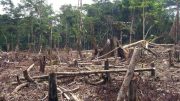A new framework for pathogen evolution exposes a world much more vulnerable to disease outbreaks than we previously believed, but it also reveals new insights into how we might anticipate and mitigate the next one.
September 3, 2020 — ![]() Editor’s note: This feature, part of a collection of stories around reducing the threat of wildlife-transmitted disease, is supported by funding from the Solutions Journalism Network. It was produced in collaboration with the Food & Environment Reporting Network, a non-profit investigative news organization.
Editor’s note: This feature, part of a collection of stories around reducing the threat of wildlife-transmitted disease, is supported by funding from the Solutions Journalism Network. It was produced in collaboration with the Food & Environment Reporting Network, a non-profit investigative news organization.
For thousands of years, an unknown virus lingered quietly among the wild ruminants of South Africa. The kudu. The giraffes. The Cape buffalo. Spread by a genus of biting midges called Culicoides, the virus lived in harmony with its hosts, rarely causing disease, until the late 18th century, when farmers began importing purebred merino sheep from Europe. Sheep are ruminants, too, of course, and before long — because it could — the virus moved in. Unlike their native counterparts, however, these newcomers hadn’t had the chance to evolve any resistance. French zoologist François Levaillant identified the disease in cattle, as well. Wayfaring through the Cape of Good Hope in the 1780s, he first recorded the clinical symptoms of what he called “tongue sickness,” or “tong-sikte” in South African Dutch, noting a “prodigious swelling of the tongue, which then fills the whole mouth and throat; and the animal is every moment in danger of being choaked [sic].”
But the wooly imports proved especially susceptible. The disease persisted, year after year, decade upon decade, flaring up in new flocks every summer. In 1905, James Spreull, a government veterinarian stationed in Grahamstown, South Africa, published the first major study of what shepherds were then calling “bluetongue.” More common than its namesake, he wrote, was a rash of other symptoms: erratic and severe fever, frothing at the mouth, swollen lips, excessive mucus. Often diarrhea. Foot lesions. Emaciation. Mortality rates within flocks varied in his report from less than 5% up to 30%, but “the loss to the farmer,” he wrote, “… is not so much bound up in the number of sheep which actually die as in the great loss of condition which a large percentage of the flock undergoes.”
The veterinarian believed the disease was “peculiar to South Africa,” but in 1943, the virus broke loose in Cyprus. In 1956, it swept across the Iberian Peninsula. In the mid-1960s, the World Organisation for Animal Health (OIE) classified bluetongue as a “List A” transmissible disease, fearing its spread across southern Europe. Then it spread across southern Europe and the Mediterranean, from the Greek Islands to at least nine other previously uninfected countries. By 2005, this outbreak had killed well over a million sheep, and scientists were beginning to connect the dots, blaming climate change for expanding both the range and transmission season of Culicoides imicola, the Afrotropical midge.
“For midge populations to become established in a new location, across a large water body, you need both wind-borne transport and suitable climatic and environmental conditions at the arrival location,” says Anne Jones, a data scientist at IBM Research who previously studied the disease.“Consequently, climate change makes expansion to warming regions more likely.”
But when it reached northern Europe the next summer, ultimately marching from the Netherlands to southern Scandinavia, researchers discovered something unexpected: The virus had jumped to a native midge, too, spreading the disease far wider than any of the climate models could predict. A series of compulsory vaccination programs across Europe finally quashed the spread by 2010, but just five years later, bluetongue reemerged in France and later, Germany, Switzerland and more. And as the world grows warmer, creating more suitable habitat for the virus, nearly every model suggests bluetongue outbreaks, which have caused billions of dollars of damage in the past two decades alone, are likely to increase in range, frequency and duration in the years to come.
“The bluetongue story shows how easily diseases can emerge from a background of climate change augmented by globalized trade and travel,” says Daniel Brooks, senior research fellow of the Harold W. Manter Laboratory of Parasitology at the University of Nebraska State Museum. “The planet is a minefield of evolutionary accidents waiting to happen.”
Welcome to the emerging infectious disease crisis.
A Perfect Storm
Bluetongue. African swine fever. West Nile. Dengue. Influenza. Avian influenza. Zika. Ebola. MERS. Cholera. Anthrax. Wheat rust. Lyme disease. Malaria. Chagas. SARS. And now, with a price tag of at least US$9 trillion and nearly a million lives, Covid-19. The list of emerging infectious diseases (EIDs), which plague everything from humans to crops and livestock, goes on. And on. And on. Some of these diseases are brand new or previously undiscovered; others — like bluetongue — are repeat offenders, flaring up in new hosts or novel environments. Some are highly pathogenic, others less so. Many you’ll recognize, but most — unless they’ve personally infected you, or your loved ones, or the food or water you rely on — you won’t.
In July 2019, Brooks and two other parasitologists, Eric Hoberg and Walter Boeger, published The Stockholm Paradigm: Climate Change and Emerging Disease. The book offers a new understanding of pathogen-host relationships that explains our current onslaught of EIDs — what Eörs Szathmáry, director general of the Centre for Ecological Research and member of the Hungarian Academy of Sciences, calls an “underappreciated consequence” of the climate crisis.
EIDs already cost roughly US$1 trillion annually, the authors note, major pandemics like Covid-19 notwithstanding, and they’re becoming more frequent all the time. “It’s so easy,” Brooks says. “With this combination of climate change and human beings pushing into the wild lands and the wild lands pushing back, and then global travel and global trade — boom, it goes really fast.”
Throughout Earth’s history, the researchers write, episodes of climate change and environmental disruption have largely been associated with emerging disease, scattering organisms beyond their native range and introducing novel pathogens to susceptible hosts. The retreat of the last Ice Age, for example, transformed much of Alaska from a dry grassland ecosystem to a shrubby wetland, luring moose, humans and other species further north, where they unwittingly exposed themselves to a whole new range of pathogens. In that sense, man-made global warming isn’t fundamentally different. Forests are razed. Permafrost melts. Historic droughts arise. But increased globalization and urbanization have amplified these effects by displacing even more species and opening ever more pathways to infect new hosts — like those merino sheep in Africa — and new vectors, too. During a normal year, airplanes and cargo ships now carry millions of people and countless species around the world every day, ferrying pathogens to new and often hospitable locales. The current spate of infectious diseases, in other words, isn’t an entirely new phenomenon. But spurred by what the authors call a “perfect storm” of climate change and globalization, it’s likely worse than previous episodes, and the first directly witnessed by modern humans.
30-Million-Year Difference
According to Guido Caniglia, scientific director of the Konrad Lorenz Institute for Evolution and Cognition Research, The Stockholm Paradigm is “one of the most important works at the intersection of evolutionary biology and sustainability ever written.” But in order to understand its significance, and how the authors’ breakthrough could reshape efforts to control the EID crisis, it helps to understand how the concepts finally came together.
When Brooks first began his career as a young parasitologist in the late 1970s, the field of “phylogenetic systematics,” crucial to this new understanding of pathogen-host relationships, was still highly controversial. Think of phylogenetics as genealogy on steroids, a method of reconstructing species’ evolutionary history using observable ancestral traits to reveal common ancestry.
“My first wife divorced me, in part, because one of the other postdocs said, ‘This guy’s never going to get a job doing this.’ It was that controversial,” Brooks says. “But it was using those techniques that showed me that there were parasites moving around or changing hosts, and they weren’t supposed to be.”
Like so many before him, he’d been trained to think of pathogen-host relationships as highly specialized units — so specialized, in fact, that pathogens couldn’t stray from their original hosts without a lucky mutation. So specialized that the evolutionary history — aka, the phylogeny — of the pathogen should, in theory, mirror that of the host. Still today, says Hoberg, now an adjunct professor in the Museum of Southwestern Biology at the University of New Mexico, the notion that a “magical mutation” is necessary for pathogens to adopt new hosts is common. “This is the long-held paradigm,” he says.
Though the general idea had been around since the late 19th century, Brooks actually coined the term “cospeciation” while hunting for proof of the concept as a Ph.D. student at the University of Mississippi. One of the great ironies of Brooks’ career, however, is that he has now spent the bulk of it backpedaling from the whole idea; the Stockholm Paradigm is, in some ways, a self-rebuttal. Not long after accepting a professorship at the University of British Columbia in 1980, Brooks met Hoberg, a Ph.D. student at the University of Washington who would later become chief curator of the U.S. National Parasite Collection, a repository of more than 20 million parasite specimens maintained as a reference tool by the U.S. Department of Agriculture. At the time, Hoberg was researching marine bird parasites in the Arctic, and when he tried employing Brooks’ phylogenetic method for determining cospeciation, the whole system broke down, as if he were trying to hammer a square peg into a round hole. One group of tapeworms, for example, was more than 30 million years older than the host bird itself, suggesting the parasite had previously existed in another host. Hoberg’s data ultimately exposed a pattern of newly infected hosts following periods of climate change.
Brooks was initially skeptical, given his training to the contrary, but as the years passed, his own research only seemed to reinforce Hoberg’s findings. In the mid-’90s, Brooks signed on as a consultant with a biodiversity inventory project in Costa Rica, and every previously documented parasite they found in their research area had originally resided in a different host.
“All of them,” he says flatly. “So it was exactly the same thing that Eric was finding in the Arctic.”
By the late ’90s, it was clear to Brooks and Hoberg — if not yet the greater scientific community — that cospeciation was the exception, not the rule. Evidence both historical and in real time suggested host switching was commonplace. And while they now suspected episodes of climate change were responsible for triggering these events, neither could yet explain how the jump to a new host actually happens. In other words: If not through random mutation, how do pathogens infect new hosts, jumping, say, from Cape buffalo to merino sheep — or from bats to humans?
Out Into the Slop
Over the next 20 years, Brooks and his co-authors haltingly pieced together the Stockholm Paradigm (named for the location of a series of seminal workshops), a synthesis of several ecological concepts, both old and new, that explain an uncomfortable, if increasingly obvious truth: Pathogens are not only capable of adapting to change and exploiting new hosts, they’re exceptionally good at it. Despite its rejection of the long-held dogma, the Stockholm Paradigm seems to have been generally accepted by the scientific community; reviews of the book have been largely positive, and Brooks says he hasn’t received any pushback. “I cautiously think we have made an impact,” he says.
Every species carries with it a number of ancestral traits, and those same traits are inherited by other related species. This is fortunate for pathogens, because while they are indeed specialists, they specialize on the trait itself, not the specific host. If a distant but related host (say merino sheep) is suddenly thrust into a pathogen’s environment (say South Africa) the pathogen is more than capable of making do. In the case of bluetongue, which requires an intermediary host — a vector — for transmission, the process repeated itself when the virus adopted another species of midge. The pathogen did not require any new capacity, or random mutation, to adopt another vector. All the necessary genetic resources for the pathogen to find a new home were already in place.
This process is called “ecological fitting,” and it operates under the notion that organisms never utilize all of their potential resources. The wiggle room between where a pathogen currently exists and where it could exist if given the right opportunity — between its current host and a vast range of potential ones — is called “sloppy fitness space.” Whereas traditional parasitology assumes each pathogen is tightly bound to its particular host, the idea of “sloppy fitness space” suggests that pathogens, no matter how specialized they may become, possess at least a small degree of flexibility, or an innate capacity to utilize resources beyond their current host.
“It provides the degrees of freedom for the system to respond to change,” says Sal Agosta, an associate professor of physiological ecology at Virginia Commonwealth University, who coined the term in 2008. “If it was only survival of the fittest, species would all be perfectly adapted to a specific set of conditions,” Agosta says. “But what happens when those conditions change? Everything goes extinct. But everything doesn’t go extinct.” Organisms adapt to a new environment with the traits they have in hand.
And it’s all that slop — that inherited capacity to utilize new hosts — that ultimately allows for an emerging disease crisis. When episodes of environmental disruption push species into new territories, they encounter new resources along the way. Two of Brooks’ colleagues at Stockholm University, for example, ecologists Sören Nylin and Niklas Janz, showed that a certain family of butterflies chasing their host plant into a new ecosystem encountered other suitable host plants en route. These new relationships eventually splinter off, specializing and speciating in isolation from the rest until another external disturbance pushes them out into the slop once again. Pathogens diversify more, in other words, when they’re exposed to a greater diversity of hosts. Over long periods of time, pathogens oscillate between periods of specializing and generalizing, between isolation and expansion, in reaction to environmental pressures like climate change.
“We now believe there’s no such thing as generalists and specialists, because nouns can’t evolve,” Brooks says. “There are only species that are generalized or specialized relative to how much of their sloppy fitness space they occupy. And this is what powers evolution.”
In 2015, Sabrina Araujo, a physicist at the Federal University of Paraná in Brazil, built a model to test the Stockholm Paradigm, particularly the hypothesis of ecological fitting within sloppy fitness space. In the beginning, she says, the results were underwhelming. The pattern seemed to reflect little more than natural selection: Those pathogens most adapted to their host have the highest chance of survival. But a second truth soon emerged: The ill-fitting pathogens often survive, too, and it’s that imperfection that affords them a greater opportunity to adopt new hosts. Through a stepping-stone process, even distantly related hosts can become viable options, as marginal, ill-fitting variants — or recombinations of existing genetic material — in the original host produce new variants in the next, and so on down the line.
“At that time, I believed that this work would never be cited, but as Dan predicted, it is now my most cited work,” Araujo says. In fact, Anthony Fauci, director of the National Institute of Allergy and Infectious Diseases (NIAID) and a leader in the White House Coronavirus Task Force, and David Morens, senior scientific advisor at NIAID, recently cited Araujo’s model in explaining how Covid-19 may have moved from wild bats to food animals in wet markets in Wuhan, China.
“I’ve started to see it more clearly, and I’ve become kind of scared about what our models are saying,” Araujo says. “It means that a pathogen does not need a new favored mutation” to infect another host.
It also means that pathogens are ready built for change, and that disease is yet another symptom — if indirect — of a warming planet.
Or as Brooks put it: “We’re in deep shit, and we don’t really have the option of ignoring it.”
Anticipate and Mitigate
For Brooks and his colleagues, the Covid-19 pandemic is yet another daily reminder that public policy — still relying almost exclusively on vaccinations and other reactionary measures — either hasn’t caught up, or isn’t listening, or doesn’t want to. Because while the Stockholm Paradigm exposes a world much more vulnerable to disease outbreaks than we previously believed — a world rapidly introducing new pathogens to new hosts — it also reveals new insights into how we might anticipate and mitigate the next one.
“Paradigm shifts are not easy. My countryman [Ignaz] Semmelweis went crazy because his colleagues did not appreciate what washing hands can do against infection,” says Szathmáry, speaking of the 19th century Hungarian physician. “Existing frameworks concentrate on particular aspects, like viruses and cures. But in epidemiology, prevention would be better than a cure.”
The authors of The Stockholm Paradigm crafted a blueprint based on their findings to proactively combat the EID crisis. They call it the DAMA protocol (document, assess, monitor, act), and it’s meant as an umbrella policy to streamline the inventory and surveillance programs already run by the Centers for Disease Control and Prevention, the World Health Organization and the United Nations. The National Institutes of Health recently announced the establishment of a new US$82 million initiative for EID research that “very closely parallels DAMA,” Hoberg wrote in an email. But in general, he writes, “most approaches … have focused on identified hot spots of diversity with the expectation that these hot spots are relatively static and will be the sources for pathogens in the future. This does not account for complexity in the biosphere, particularly all of the processes associated with range expansion driven by climate and environmental change.”
Researchers can hardly anticipate the spread of emerging disease if they don’t know what pathogens exist, and so far, Brooks, Hoberg and Boeger estimate, less than 10% of the world’s pathogens have been identified. The DAMA protocol emphasizes a robust inventory project focused specifically on parks, cities, pastures, cropland — anywhere that humans, livestock and wildlife might overlap, and where a novel pathogen might cause a disease. Within those areas, the protocol targets reservoir hosts — ticks, rodents, bats and more — known to harbor pathogens without ill effects. It’s the ill-fitting pathogens within those hosts, they say — those rare variants barely clinging to the margins — that are most likely to jump either directly to humans, crops or livestock, where they may fit better, or indirectly through a stepping-stone mechanism like that found in Wuhan, where Covid-19 likely made its way from asymptomatic bats to unsuspecting humans via other food animals.
“Another element of the common wisdom is that we can never predict when a new disease will emerge. This is based on the assumption that a random mutation has to arise that just happens to be able to jump to a new host,” Brooks says. “The DAMA protocol is based on the recognition that we can predict an enormous amount because switches are based on preexisting biology.”
While surveying these ecological borderlands, researchers should practice what Brooks calls “phylogenetic triage,” using a pathogen’s evolutionary history to assess its potential for disease. Species known to spread disease in other areas, or those with close relatives that spread disease, should be prioritized. Researchers should then monitor these pathogens for changes in geographic range, host range and transmission dynamics. And finally, all of this information must be swiftly translated into public policy. This last step is critical, they say, and too often neglected. Researchers in China, for example, first warned of a potentially transmittable coronavirus in bats more than 15 years ago, but the information was never translated into public policy that might have prevented the spillover of Covid-19.
“They already knew there was a coronavirus in bats. They knew there were people that were seropositive. And so you start to connect the dots for how people are being exposed,” Hoberg says. “You try to break down the pathways. You try to stop the potential for transmission.”
A Warning Shot Across the Bow
Even if the DAMA protocol were fully realized, EIDs are here to stay. The goal, the experts say, is not to prevent disease emergence, but to cushion the blow. So long as climate change continues to stir up the biosphere, pathogens will continue to move, and even after resistance evolves, they’ll persist as so-called “pathogen pollution” in other species, lying in wait to strike again. Russian authorities, for example, are now warning against marmot hunting after several new cases of bubonic plague, which first ravaged the world more than six centuries ago, surfaced in Mongolia. And Covid-19, the authors say, could return to the wild through humans, or more likely our pets, only to reemerge after we’ve finally declared victory. It’s why Brooks called for the investigation of susceptible nonhuman reservoirs for Covid-19 shortly after the pandemic materialized, why Hoberg encourages testing potential new ruminant hosts for bluetongue, and why the authors of The Stockholm Paradigm insist the hunt for potential disease-causing organisms must be proactive and ongoing in a biosphere doubly animated by climate change and globalization.





